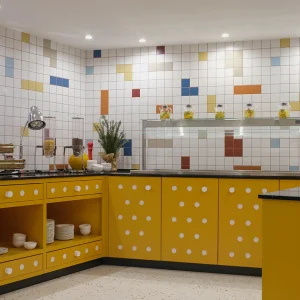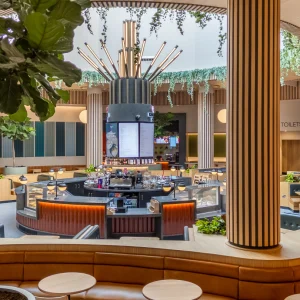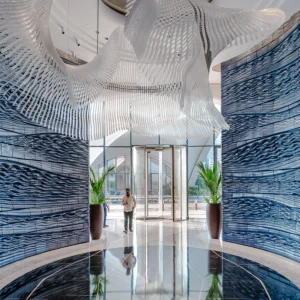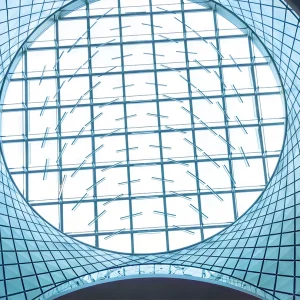
Did you have a background in design prior to your role at the V&A?
A: I studied graphic design and photography at the Glasgow School of Art before moving into publishing and then exhibition design at the Aberdeen Gallery and Museums and the Museum of London. My interest has been how to create spaces to physically communicate the narrative that the curators and educators are trying to put across while creating spaces that delight our visitors.

The V&A’s Medieval & Renaissance galleries, designed by MUMA
Do you have any particular design heroes?
I have lots, including William Morris, Mies van der Rohe and Peter Zumthor. Other design heroes are quite often the people I’m working with at the time. So at the moment, it’s Kengo Kuma, who I’m working with on the V&A’s new Dundee museum, and Amanda Levete, who is designing our Exhibition Road project. Another is Laura Lee of Maggie’s cancer care centres. What she’s achieved through commissioning exceptional architects makes her a design hero.
What is your job’s most challenging part?
There are many! The major difficulty is how to manage construction projects, with all their dust and noise, in a building that is open to the public and full of precious objects, so that visitors still have a rich experience and staff are still able to do their work.
How do you go about commissioning designers and architects?
I don’t have a regular roster – I want to choose the right architect or designer for the right job. But we do run competitions for the lead designer – either through the OJEU process or, if it’s for smaller, temporary exhibitions, we’ll put together a list of five or six designers and ask them to come up with concepts. And we do pay – it might be a bit token but I think it’s important, as a museum of design, to show some respect for the effort designers put into their pitch. I like working with a whole range of practices, from the new to the established. I think it’s important that the V&A plays a part in helping new and emerging designers.

Projects that Gemmill considers among the most successful includes the Sackler Centre by Softroom
How many different design projects do you commission a year?
Each year we commission two or three capital projects plus three or four temporary exhibitions. Some take quite some time – the Medieval & Renaissance galleries for example took seven years – so it’s not unusual to have around eight projects live at any one time.
What different skills are needed for a temporary exhibition and a permanent gallery?
You don’t have to be so robust with temporary shows as when designing for a gallery that’ll be there for years, and you can take more risks with technology and experiment, as we did with the Hollywood Costume and David Bowie exhibitions. Permanent galleries need to look good in 25 years’ time so we need them to be classic and beautiful and work well with the architecture of the museum. You’re much less aware of the building envelope with temporary exhibitions, but all should convey the message that design is important, whether subliminally or explicitly.
Are you regularly approached by design teams?
Yes – and I love that. I try to make time every month to see one or two. I certainly get a lot of Christmas cards from designers – beautifully designed ones of course!

Projects that Gemmill considers among the most successful includes the Sackler Centre by Softroom
What do you look for from a design team?
Innovative ideas first, and a willingness to understand and address museum concerns.
Should gallery design be unobtrusive?
We don’t really do white or black-box galleries – all our spaces have great character. In our new temporary exhibition gallery designed by Amanda Levete the space itself will be as much a part of the experience as the exhibitions it will show, which I think is right – particularly for the V&A. The juxtaposition of old and new is very interesting, for example the integration of the beautifully sleek white concrete staircase and glass lift by MUMA as part of the Medieval and Renaissance galleries. It’s a delightful contemporary intervention.
Over the decades some of my predecessors had felt that the V&A’s highly decorated interiors interfered with the enjoyment and understanding of the collections, and covered them up. We have revealed and restored much of the original decoration over recent years, and I don’t think it interferes at all. Where we need to be careful, particularly in permanent galleries, is in the use of graphic design. Graphic styles can date very quickly.
What is the hardest aspect to get right?
Stitching in contemporary architectural interventions with the historic fabric. They mustn’t look completely foreign, but nor should they attempt to recreate what’s already there. Our legacy should be to add the very best design of the moment as part of the constantly evolving V&A.

She is excited by the Exhibition Road project, by Amanda Levete Architects, which will reveal previously unseen facades from thecourtyard. One of her favourites is the women’s loos, by Glowacka Rennie
How long do you expect the design of a permanent gallery to last?
On the whole we design for 25 years. We never design for less than 10 years, and that’s only when we know that space is going to be subject to change.
What projects do you feel have turned out particularly successfully?
There’s one very small one I really love – the redesign of the women’s loos. I commissioned a very young practice, Glowacka Rennie, to work with the Swiss graphic artist Felice Varini. He came up with a wonderful ceiling piece called 6 Circles of Disorder with lots of fragmented blue lines that at one point become six perfect circles. Of the larger projects, I’d choose the Medieval & Renaissance galleries by MUMA, the Sackler Centre by Softroom and the wonderful Jewellery gallery by Eva Jiricna.
What advantages will the Exhibition Road project by Amanda Levete Architects bring to the visitor experience?
The Exhibition Road project creates a new open-air courtyard and a new entrance and welcome into the heart of the V&A. This project will transform our visibility and access from Exhibition Road by opening up sections of the Aston Webb screen which currently separates the museum from the road in a rather forbidding way. The courtyard will reveal splendid facades that have never been seen and provide a new outdoor gallery for events, installations and performances. And our new gallery for headline exhibitions gives us a single uninterrupted space that can be designed for any exhibition without the constraints we currently have.
What other key projects are underway at the moment?
The £12.5m Europe 1600-1800 galleries, which ZMMA is designing, and the Clothworkers’ Centre designed by Haworth Tompkins at our Blythe House Olympia site, which will make more of our research collections accessible to scholars, students and the creative industries. We’re renovating the iconic Cast Courts – and we have a new design museum opening in Scotland in a couple of years’ time.





